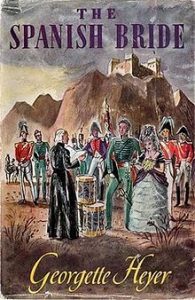“His Lordship did not love his men, but he understood them. Presently he would send a strong force into Badajos and erect a gallows there, but not until his wild, heroic troops had glutted themselves with conquest.
“Had his Lordship cared, after the bloody combat at Ciudad Rodrigo, when he had met the men of the 95th Rifles clad in every imaginable costume, excepting only the dress of a rifleman? Not a bit!
“They had their swords stuck full of hams, tongues, and loaves of bread; they were weighed down by their plunder; but when they had set up a cheer for His Lordship, he had acknowledged it in his usual stiff way . . . And when he was told that he beheld some of his crack troops he had given a neigh of laughter and ridden on.”
No, The Spanish Bride is by no means a romantic fairy tale of the warfare of a century and a quarter ago-all waving banners, shrilling trumpets, and soldiers animated by nothing but the highest ideals.
It is a comprehensive picture, and a true one, with nothing left out.
Then – as now
At such a time as this, with the newspapers carrying, every day, news of further advances on the part of troops driven forward by the will of a ruthless, determined, strongly armed aggressor, there is a message of comfort in this story of a desperate war, against another Continental dictator, over a hundred years ago.
Then, as now, the greater part of Europe was under the heel of a tyrant. Germany, Spain, Italy, huge sections of central Europe were dominated by Napoleon.
England stood alone!
But then, as now, she had her fleet and control of the seas! Bonaparte threatened invasion. His troops were massed at Boulogne ; flat-bottomed boats were even built to convey them over the Channel. But that invasion was not fated to be made. After a long and weakening war, England emerged triumphant.
Perhaps this novel is not everybody’s meat. What book is? But it can be recommended to all those who want a first-class story, a real honest-to-goodness love interest, and a background of events that changed the face of Europe.
 WHEN WELLINGTON GAVE THE BRIDE AWAY
WHEN WELLINGTON GAVE THE BRIDE AWAY The heroic story of the Army of the Peninsula has been handled in such a way as to make you want to read more of it. Badajos, Salamanca, Vittoria-these historic engagements and other lesser ones come to life under Miss Heyer’s pen as if they
The heroic story of the Army of the Peninsula has been handled in such a way as to make you want to read more of it. Badajos, Salamanca, Vittoria-these historic engagements and other lesser ones come to life under Miss Heyer’s pen as if they



